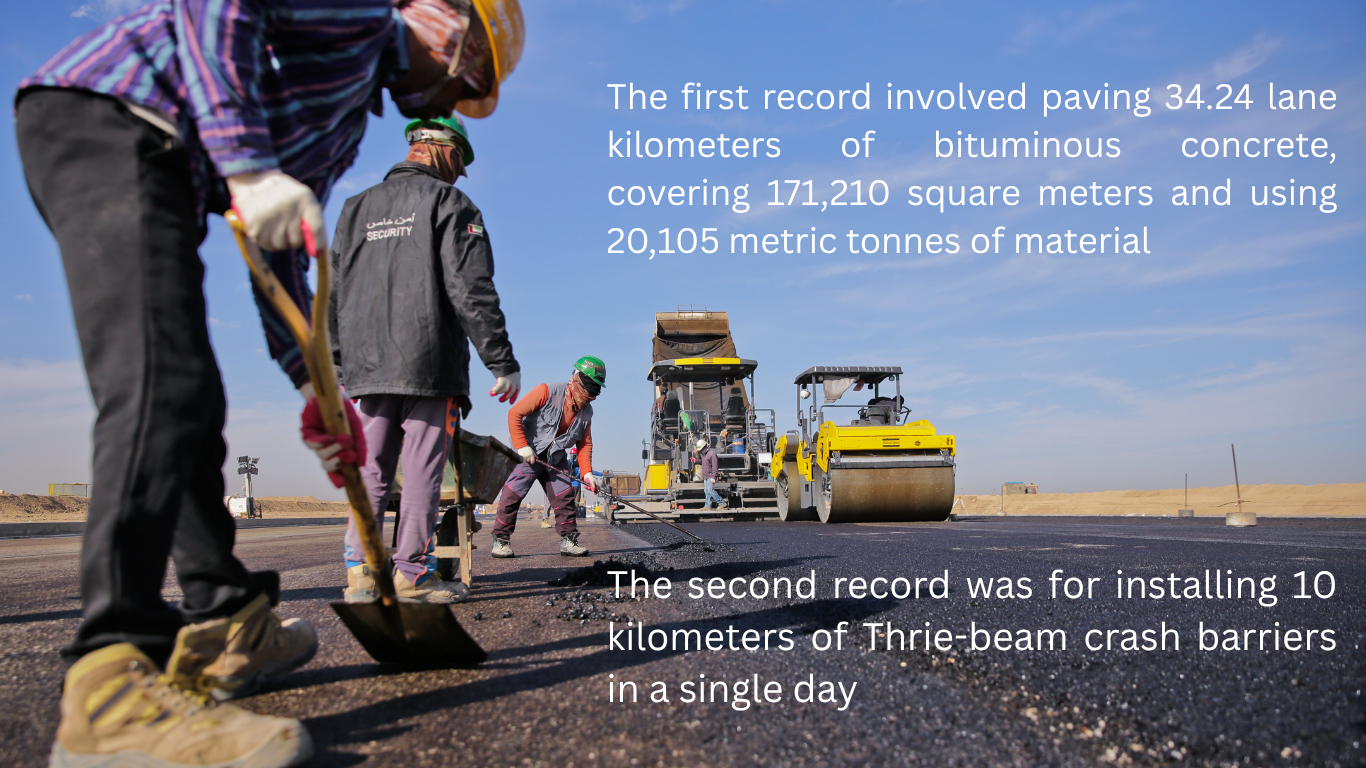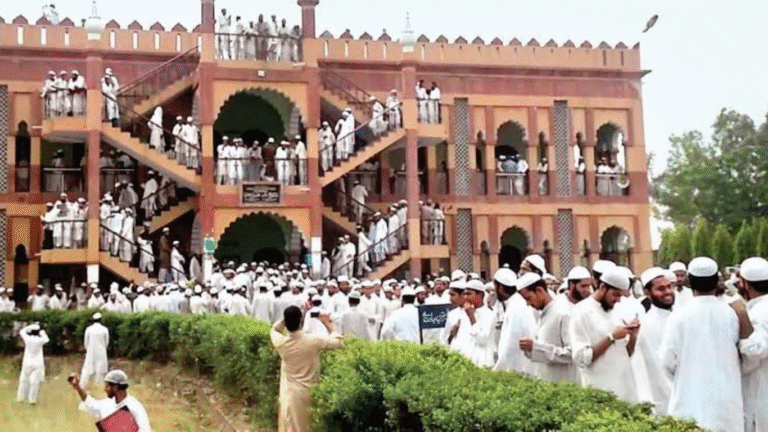
The Ganga Expressway, a massive road project in Uttar Pradesh, India, is more than just a highway—it’s a symbol of ambition, innovation, and sheer determination. Spanning 594 kilometers in its first phase, this six-lane (expandable to eight) expressway is set to connect Meerut to Prayagraj, slashing travel time from 12 hours to just 6-7. But what’s grabbing headlines is the project’s incredible feat: setting two world records in just 24 hours for highway construction and crash barrier installation. On May 17-18, the Ganga Expressway project achieved a remarkable feat: setting two world records in just 24 hours. Between Hardoi and Unnao districts, construction teams laid 34.24 lane kilometers of bituminous concrete and installed 10 kilometers of metal beam crash barriers. By utilizing cutting-edge AI-enabled precision technology, the teams behind this project have demonstrated to the world what India’s infrastructure scene is capable of. This article explains the details of these records, the tech that made them possible, and what the expressway means for Uttar Pradesh and beyond, with live updates as the project races toward its completion.
The Ganga Expressway: A Game-Changer for Uttar Pradesh
The Ganga Expressway is one of India’s most ambitious infrastructure projects, designed to link 12 districts across Uttar Pradesh, from Meerut in the west to Prayagraj in the east. With a planned extension to Ballia, it could become the country’s longest expressway at 1,047 kilometers. Spearheaded by the Uttar Pradesh Expressways Industrial Development Authority (UPEIDA), the project is being built using the Design-Build-Finance-Operate-Transfer (DBFOT) model, with major players like Adani Enterprises and Patel Infrastructure leading the charge. Costing over ₹37,350 crore, including ₹9,500 crore for land acquisition, the expressway promises to boost trade, tourism, and connectivity. Despite delays pushing its completion to June 2026, the project’s record-breaking achievements have already put it on the global map, showcasing India’s growing prowess in infrastructure development.
Why the Ganga Expressway Matters
This expressway isn’t just about faster travel; it’s about transforming lives. By connecting rural and urban areas, it will make it easier for farmers to reach markets, businesses to transport goods, and people to access opportunities. The route passes through key districts like Hapur, Amroha, and Shahjahanpur, fostering economic growth. With a speed limit of 120 kmph and plans for amenities like food courts and rest stops, it’s designed for comfort and efficiency.
A Vision Revived
First proposed in 2007 by then-Chief Minister Mayawati, the project stalled for years. In 2019, Chief Minister Yogi Adityanath brought it back to life, allocating ₹2,000 crore to kickstart construction. The foundation stone was laid by Prime Minister Narendra Modi in December 2021, marking a new chapter for Uttar Pradesh’s infrastructure dreams.
World Records That Made History
On May 17-18, 2025, the Ganga Expressway project achieved something extraordinary: two world records in just 24 hours. Between Hardoi and Unnao districts, construction teams laid 34.24 lane kilometers of bituminous concrete and installed 10 kilometers of metal beam crash barriers. These feats, certified by the Golden Book of World Records, Asia Book of Records, and India Book of Records, highlight the project’s scale and speed. Chief Minister Yogi Adityanath praised the UPEIDA, calling it a result of “excellent planning, technical expertise, and committed teamwork.” These records aren’t just numbers—they’re proof of India’s ability to push boundaries in infrastructure.
Record 1: Laying 34.24 Lane Kilometers in 24 Hours
The first record involved paving 34.24 lane kilometers of bituminous concrete, covering 171,210 square meters and using 20,105 metric tonnes of material. This surpassed the previous record of 27 lane kilometers set on the Ghaziabad-Aligarh Expressway in 2023. Five hot mix plants, each with a 200-tonne-per-hour capacity, worked non-stop, showcasing incredible coordination and efficiency.
Record 2: Installing 10 Kilometers of Crash Barriers
The second record was for installing 10 kilometers of Thrie-beam crash barriers in a single day—a first in expressway construction history. These barriers, designed to keep vehicles on the road during accidents, ensure safety. Patel Infrastructure’s subsidiary, Road Shield Private Limited, executed this task with precision, setting a new global standard.
AI-Enabled Precision Technology: The Secret Sauce
What made these records possible? A big part of the answer lies in AI-enabled precision technology. The Ganga Expressway project partnered with ETH Zurich University and RTDT Laboratories AG from Switzerland to integrate AI and sensor-based systems. This tech monitors road quality in real-time, catching defects during construction rather than after. Sensors measure road smoothness and comfort, allowing immediate fixes. This approach, a first for India, ensures the expressway meets international standards. After its success here, UPEIDA plans to use it on the Gorakhpur Link Expressway, signaling a new era for road construction in India.
How AI Improves Construction
AI technology tracks every detail, from pavement thickness to slope alignment. By analyzing data in real-time, it reduces human error and ensures consistent quality. For the Ganga Expressway, this meant faster work with fewer mistakes, saving time and resources. It’s like having a super-smart supervisor on-site, guiding every move.
Why This Tech Matters
Traditional road checks happen after construction, making fixes costly and slow. AI changes that by catching issues early. This not only speeds up the process but also makes roads safer and more durable. It’s a game-changer for India’s infrastructure, setting a model for future projects.
The Role of Patel Infrastructure and Adani Enterprises
Patel Infrastructure Limited, based in Gujarat, and Adani Road and Transport Limited (ARTL) were the masterminds behind the record-setting work. Starting at 5:00 AM on May 17 and finishing by 5:00 AM on May 18, their teams worked tirelessly. Arvind Patel, Managing Director of Patel Infrastructure, called it a “reflection of Indian engineering brilliance.” Their experience, combined with advanced tech, made the impossible possible. Patel Infrastructure’s history of setting records, like the 2021 Delhi-Vadodara Expressway feat, proves their expertise in delivering massive projects on time.
Patel Infrastructure’s Legacy
Patel Infra has a track record of excellence, from building India’s first eight-lane rigid pavement expressway to completing a 48.88-km highway in Rajasthan. Their work on the Ganga Expressway adds another feather to their cap, showing their ability to handle complex, high-stakes projects.
Adani’s Role in the Project
Adani Enterprises, through ARTL, secured contracts for multiple packages of the expressway. Their involvement ensures financial and technical muscle, helping the project stay on track despite its massive scale. Their partnership with Patel Infrastructure was key to the record-breaking effort.
Challenges and Delays
Despite its successes, the Ganga Expressway hasn’t been without hurdles. Originally set for completion before the Maha Kumbh 2025, the project is now slated for June 2026 due to delays. Land acquisition, which began in 2019 and was mostly completed by 2021, was a major challenge, costing ₹9,500 crore. Environmental clearances and the sheer scale of the 594-km stretch also slowed progress. Yet, with 84% completion as of June 2025, including 99% earthwork and 1475 of 1500 structures finished, the project is moving steadily toward its goal.
Overcoming Land Acquisition Issues
Acquiring land across 12 districts was no small task. Disputes and negotiations slowed early progress, but UPEIDA’s persistence paid off. By 2021, most of the land was secured, allowing construction to ramp up.
Environmental and Logistical Hurdles
Environmental clearance from the Ministry of Environment, Forest and Climate Change was granted in 2021, but balancing development with ecological concerns remains tricky. Measures to minimize deforestation and protect ecosystems are in place, showing a commitment to sustainable construction.
Economic and Social Impact
The Ganga Expressway is more than a road—it’s a catalyst for change. By connecting rural areas to cities, it will boost agriculture, trade, and tourism. Industrial corridors along the route, including pharma parks and IT hubs, are already sparking investment. Real estate prices near the expressway are expected to rise 15-30%, especially around Jewar, where a new airport will connect to the expressway. For locals, it means better jobs, faster travel, and access to markets, transforming Uttar Pradesh’s economy.
Boosting Real Estate and Industry
The expressway’s route through Meerut, Kanpur, and Varanasi is driving real estate growth. New industries, from textiles to tech, are popping up, creating jobs and opportunities. The connection to Noida International Airport will further fuel development.
Connecting Communities
For rural villages, the expressway means easier access to cities, schools, and hospitals. Nine planned convenience facilities with food courts and restrooms will make travel comfortable, bridging the gap between urban and rural Uttar Pradesh.
Future Extensions and Connectivity
The Ganga Expressway’s first phase is just the beginning. Phase 2 includes extensions from Meerut to Haridwar and Prayagraj to Ballia, stretching the total length to 1,047 kilometers. These spurs will connect to the Char Dham Highway and Purvanchal Expressway, creating a seamless network across northern India. A new 74.3-km expressway linking the Ganga Expressway to Noida International Airport will further enhance connectivity, making Uttar Pradesh a hub for travel and trade.
Phase 2: Expanding the Vision
The Meerut-Haridwar and Prayagraj-Ballia extensions will make the expressway a lifeline for eastern and western Uttar Pradesh. These additions, approved in January 2025, are already in the planning stage, with detailed project reports underway.
Linking to Other Expressways
Connections to the Yamuna Expressway, Purvanchal Expressway, and Bundelkhand Expressway will create a robust network, linking Delhi, Bihar, and beyond. This integration will cut logistics costs and boost India’s manufacturing sector, aligning with national goals like Vision 2047.
Live Updates on the Ganga Expressway
As of June 27, 2025, the Ganga Expressway is 84% complete, with a projected opening in June 2026. Recent posts on X highlight ongoing excitement, with users praising the project’s speed and records. Construction teams are now focusing on finishing the remaining 16%, including final paving and safety features. UPEIDA is also exploring more AI tech to ensure quality. Stay tuned for updates as this mega-project nears its grand debut, promising to reshape Uttar Pradesh’s future.
June 2025 Progress Report
As of June, 99% of earthwork and 91% of dense bituminous macadam (DBM) are done. With 1475 structures completed, the focus is on final touches like signage and barriers. The project remains on track despite earlier delays.
What’s Next for the Expressway
The next few months will see intensified efforts to complete the remaining stretches. UPEIDA is also planning to test the expressway’s airstrip capabilities, following successful Indian Air Force drills in May 2025. The future looks bright for this record-breaking project.
Conclusion: A New Era for India’s Infrastructure
The Ganga Expressway is more than a road—it’s a testament to India’s growing infrastructure muscle. By setting two world records in 24 hours, using AI-enabled precision technology, and connecting 12 districts, it’s paving the way for a stronger, more connected Uttar Pradesh. Despite challenges, the project’s progress and impact are undeniable. As it heads toward completion in 2026, the expressway is a shining example of what planning, technology, and teamwork can achieve. Keep an eye on this space for more updates as the Ganga Expressway continues to make history.



